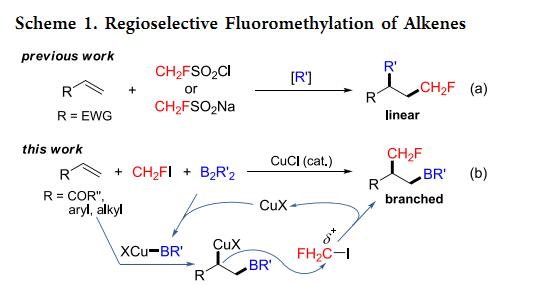ABSTRACT: A copper-catalyzed borylfluoromethylation of alkenes with fluoromethyl iodide and diboron reagents was disclosed. This protocol afforded the previously unknown and synthetically useful borylfluoromethylated alkanes in good yields and excellent regioselectivity. Its synthetic application was illustrated through the derivatization of organoboron products and preparation of monofluorinated ibuprofen. KEYWORDS: fluoromethylation, borylation, alkene, copper, regioselective

Quzhou Fluorio Pharmtech Co.,Ltd produce Fluoroiodomethane 373-53-5
Nuo-Yi Wu,
†
Xiu-Hua Xu,
‡
and Feng-Ling Qing*,†,‡
†
Key Laboratory of Science and Technology of Eco-Textiles, Ministry of Education, College of Chemistry, Chemical Engineering
and Biotechnology, Donghua University, 2999 North Renmin Lu, Shanghai 201620, China
‡
Key Laboratory of Organofluorine Chemistry, Center for Excellence in Molecular Synthesis, Shanghai Institute of Organic
Chemistry, University of Chinese Academy of Science, Chinese Academy of Science, 345 Lingling Lu, Shanghai 200032, China
ABSTRACT: A copper-catalyzed borylfluoromethylation of alkenes with fluoromethyliodide and diboron reagents wasdisclosed. This protocol afforded the previously unknown and synthetically useful borylfluoromethylated alkanes in good yields and excellent regioselectivity. Its synthetic application wasillustrated through the derivatization of organoboron productsand preparation of monofluorinated ibuprofen.
KEYWORDS: fluoromethylation, borylation, alkene, copper, regioselective

The presence of fluorine atom(s) in a group could affect its
electronic and physicochemical properties.
1
For instance,fluoromethyl group (CH2F) normally acts as a metabolically
stable bioisostere for methyl group (CH3). Furthermore, theCH2F group is also considered as a CH2OH group mimic.
2
As a consequence, the fluoromethylated compounds have wide-spread applications in agrochemicals, pharmaceuticals, andmaterials.3Conventionally, the fluoromethylated compounds are prepared via C−H fluorination of CH3-containingcompounds 4or fluorination of functionalized substrates. 5However, these methods have some limitations, such as narrow substrate scope, low regioselectivity, or prior
installation of a functional group. Alternatively, the method of choice for the preparation of fluoromethylated compoundsinvolves indirect fluoromethylation using fluoromethylating agents bearing a suitable auxiliary, followed by the removal of
the auxiliary.
6Compared with the indirect methods, the directfluoromethylation through electrophilic,
7nucleophilic,
8andradial pathways9are more attractive because of the atom andstep economy. Recently, the groups of Zhang,10aHu,10bWang,10cand Baran10d have also reported transition-metal-catalyzed direct fluoromethylation of aryl boronic acids(esters), halides, and zinc reagents.Alkenesareprevalentchemicalfeedstocksinorganic
synthesis. Recently, the difunctionalization of alkenes for theincorporation of both fluoroalkyl and another functional groups has been extensively studied for the synthesis of fluorine-containing compounds.
11However, only three exam-ples of fluoromethylation of alkenes have been reported
(Scheme 1a).
12In all these cases, the addition of CH2F radical to electron-deficient alkenes gave the linear fluoromethylated
products. Organoboron compounds are versatile intermediates for
organic synthesis. Recently, borylative difunctionalization of
unsaturated carbon−carbon bonds has emerged as a powerful approach to highly functionalized alkylboranes.
13
Among them,

copper-catalyzed arylborylation,
14
alkylborylation,
15
cyanobor-
ylation,
16
and aminoborylation17
of alkenes have been
extensively investigated. Inspired by these works,
14−17
we
envisioned that the borylcupration of alkenes, followed by
electrophilic fluoromethylation, might serve as a novel method
for fluoromethylation of alkenes. Herein, we disclose a copper-
catalyzed regioselective borylfluoromethylation of alkenes with
fluoromethyl iodide and diboron reagents for the formation of
the branched fluoromethylated compounds (Scheme 1b).
18
We commenced our studies with the borylfluoromethylation
of N-methyl-N-phenylacrylamide (1a) with CH2FI and B2pin2
(Table 1). Only a trace of the desired product 2a was formed
in the presence of CuCl, Binap, and NaOt-Bu in THF (entry
1). Screening of different solvents demonstrated that polar
solvents including DMAc, DMF, and DMSO could promote
this reaction, and DMSO was optimal to provide 2a in 65%
yield (entries 2−5). The effect of the ligand was then
investigated. When nitrogen-based ligand phen or N-

http://pubs.acs.org/action/showCitFormats?doi=10.1021/acscatal.9b01530
http://dx.doi.org/10.1021/acscatal.9b01530
Contact: Mr Hsu
Phone: +86(0)1815701-8567
Tel: +86(0)570780-5618
Email: sales@fluorio.com
Add: No.5,Longfei Road,Longyou Eco-Tech Development Zone, Quzhou, Zhejiang, China